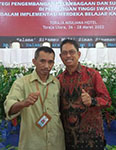Akuatikisle: Jurnal Akuakultur, Pesisir dan Pulau-Pulau Kecil
Full Length Article
The effect of deacetylation temperature on quality crab chitosan (Portunus pelagicus)
Highlights
Generate NLP AI by Wizdam ID.
Abstract
Crab (Portunus pelagicus) is a fishery export commodity, especially to Japan, the European Union and the United States. On the other hand, the crab part, namely the shell, is still not utilized optimally so it becomes waste. To make crab shells valuable, several studies have revealed the presence of useful substances known as chitin and chitosan. Therefore, this research was carried out with the aim of knowing the effect of deacetylation temperature on the quality of chitosan and the optimal deacetylation temperature so as to produce good quality chitosan. Method: This study employs an experimental methodology based on Fully Randomized Design (CRD) analysis. Several deacetylation temperature treatments (00C, 900C, 950C, 1000C, 1050C, 1100C, 1150C, 1200C) were repeated three times in this study's design. Analyses of yield, moisture content, ash content, protein content, and acetyl content serve as test parameters. Result: The results showed that the treatment using different deacetylation temperatures had a very significant effect (Fcrit > Ftable 1%) on water content, ash content, protein content, acetyl content and had no significant effect (Fcrit > Ftable 5%) on the yield. The optimal deacetylation temperature was 1200C, with a yield of 19.050%, water content of 8.340%, ash content of 0.022%, protein content of 0.198%, and acetyl content of 84.870%. Conclusion: The conclusion based on analysis that the best temperature deacetylation in producing quality chitosan crab is 1200C.
Keywords
Introduction
Section snippets
Material and Methods
Materials and methods from the full-text PDF of this article cannot be displayed.
Results
Results from the full-text PDF of this article cannot be displayed.
Discussion
Discussion from the full-text PDF of this article cannot be displayed.
Conclusions
Conclusions from the full-text PDF of this article cannot be displayed.
Acknowledgment
Acknowledgment from the full-text PDF of this article cannot be displayed.
Competing interest
The authors declare that they have no known competing financial interests or personal relationships that could have appeared to influence the work reported in this paper.
Conflict of interest
The authors declare that the research was conducted in the absence of any commercial or financial relationships that could be construed as a potential conflict of interest.
Ethical approval acknowledgements
No ethical approval required for this article. All procedures followed were in accordance with the ethical standards of the responsible committee on human experimentation (institutional and national) and with the Helsinki Declaration of 1975, as revised in 2008 (5)
Supplementary files
Data sharing not applicable to this article as no datasets were generated or analysed during the current study, and/or contains supplementary material, which is available to authorized users.
Bibliographic Information
Cite this article as:
-
Submitted
15 November 2024 -
Revised
16 December 2024 -
Accepted
8 January 2025 -
Published
17 January 2025 -
Version of record
11 May 2025 -
Issue date
31 May 2025
-
Academic subject
Aquaculture; Fisheries Science
Keywords
Copyright
Copyright © 2025 Mosriula Ula, Anshar, Karyawati, Samsibar, Abdul Rakhfid, Rochmady. Sangia Research Media and Publishing. Production and hosting by Sangia (SRM™).  This work is licensed under a Creative Commons Attribution-ShareAlike 4.0 International License.
This work is licensed under a Creative Commons Attribution-ShareAlike 4.0 International License.
Disclaimer: All claims expressed in this article are solely those of the authors and do not necessarily represent those of their affiliated organizations, or those of the publisher, the editors and the reviewers. Any product that may be evaluated in this article or claim that may be made by its manufacturer is not guaranteed or endorsed by the publisher.
Comments on this article
By submitting a comment you agree to abide by our Terms and Community Guidelines. If you find something abusive or that does not comply with our terms or guidelines please flag it as inappropriate.




